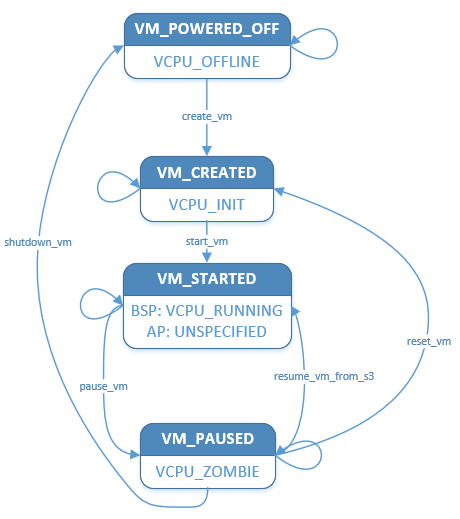VM Management¶
The ACRN hypervisor maintained a dedicated VM structure instance for each running VM, and a series VM APIs like create_vm, start_vm, reset_vm, shutdown_vm etc are used to switch a VM to the right state, according to the requirements of applications or system power operations.
VM structure¶
The acrn_vm structure is defined to manage a VM instance, this structure
maintained a VM’s HW resources like vcpu, vpic, vioapic, vuart, vpci. And at
the same time acrn_vm structure also recorded a bunch of SW information
related with corresponding VM, like info for VM indentifier, info for SW
loader, info for memory e820 entries, info for IO/MMIO handlers, info for
platform level cpuid entries, and so on.
The acrn_vm structure instance will be created by create_vm API, and then
work as the first parameter for other VM APIs.
VM state¶
Generally, a VM is not running at the beginning: it is in a ‘powered off’ state. After it got created successfully, the VM enter a ‘created’ state. Then the VM could be kick to run, and enter a ‘started’ state. When the VM powers off, the VM returns to a ‘powered off’ state again. A VM can be paused to wait some operation when it is running, so there is also a ‘paused’ state.
Figure 129 illustrates the state-machine of a VM state transition, please refer to CPU Virtualization for related VCPU state.

Figure 129 Hypervisor VM State Transition
VM State Management¶
Pre-launched and Service VM¶
The hypervisor is the owner to control pre-launched and Service VM’s state by calling VM APIs directly, and it follows the design of system power management. Please refer to ACRN power management design for more details.
Post-launched User VMs¶
DM is taking control of post-launched User VMs’ state transition after SOS boot up, and it calls VM APIs through hypercalls.
SOS user level service like Life-Cycle-Service and tool like Acrnd may work together with DM to launch or stop a User VM. Please refer to ACRN tool introduction for more details.